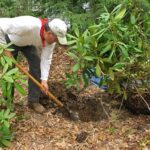This expert guide will teach you how to plant trees and hedges, a way to add beauty and privacy to your yard. Learn about how to choose the right trees and hedges for your needs, and how to plant and care for trees and hedges yourself.
Plant Selection
Planting
Staking Trees
Watering & Fertilizing
You can find deciduous trees sold as bare-root stock during their dormant season (late fall through early spring) or year-round as balled-and-burlapped or container plants. Evergreens and conifers can be found in balled-and-burlapped form from early fall through spring or in containers throughout the year.
Plant Selection
Look for plants with strong trunks and branches. Bare-root plants should have fresh-looking roots. Balled-and-burlapped plants should have root balls that are completely covered and that feel firm and moist. Container plants should not have the roots growing in a mat out of the bottom of the container. Evergreens and conifers should have healthy foliage and be free of insects.
Take care when handling a balled-and- burlapped tree. Support the root system when you’re moving the tree, and don’t hold it by the trunk. These plants can be very heavy, so you may want to enlist some help moving them.
Planting
When planting, start with a hole that is twice the width of the root ball and slightly shallower than the root system. Taper the sides of the hole slightly outward at the bottom, and then dig deeper around the bottom edges of the hole to allow room for the roots to grow downward and to prevent the soil from settling. Shape the soil in the center of the hole into a rounded cone to serve as a base for the plant. Save the soil you removed to fill in around the new plant. Trees generally do better if planted in the same soil as the surrounding garden bed rather than in amended soil. The exception is balled-and-burlapped trees. They are usually grown in heavy soil. If your garden soil is light, add amendments to the excavated soil.
Soak a bare-root tree in water for four hours before planting. Situate the tree so the top of the root ball is slightly above the surrounding soil. Spread the roots over the cone and downward. Hold the plant in place and then start filling in the hole with the soil you removed. As you fill in the hole, make sure the soil is firmly packed. When the soil is about 4 inches from the top of the hole, add water to settle it in place. If the plant starts to settle as well, add more soil underneath the root ball. Finish filling in with soil, and then water again. Don’t overwater; the soil should be moist but not soggy.
For a balled-and-burlapped plant, the top of the root ball should rest about 2 inches above the soil line. If the covering is burlap, untie the top and pull the burlap about halfway down the root ball. If the covering is synthetic, remove it completely.
Fill the hole with soil, firming it as you go, until it is about 4 inches from the top. Moisten the soil, and add more soil beneath the plant if it has settled. Continue filling the hole and firming the soil; when you’re finished, moisten the soil until it is thoroughly wet but not soaking.
If planting from a container, gently remove the plant; you may need to tap on the bottom of the container to loosen the root ball. Place the plant on the cone so the root ball is slightly above the surrounding soil. Spread the roots out around the cone and fill in the hole with soil, firming it as you go. Once you’ve finished filling in the hole, water until the soil is moist but not soggy.
Staking Trees
Most trees don’t require staking, but if a tree has a weak trunk, is very top heavy, or is exposed to a constant wind, staking may be necessary. Place two stakes in the ground on either side of the root ball. Tie the tree to the stakes as low as possible but at least a foot above the ground. If you’re adding support because the tree trunk is weak, determine where to place the ties by holding the trunk in place with one hand and running your other hand up the trunk beginning at soil level. Note the spot where the tree remains straight, and tie the tree to the stakes about 6 inches above that spot.
Choose ties made from a soft, wide material. Loop each tie around the trunk and then tie it to a stake. Keep the ties loose; there should be about 2 inches of slack. Remove the stakes and ties after the first year.
Watering & Fertilizing
Regular watering is essential for all newly planted trees, even those that are drought-tolerant. To encourage tree roots to extend deep into the soil, make a watering basin around the tree by forming one berm outside the tree’s drip line, or canopy, and another berm about 6 inches from the crown of the trunk.
Other options include soaker hoses, deep root soakers, or drip irrigation. Water newly planted trees when the soil is dry to 2 inches deep. Once a tree is established, water only as needed. An exception is if trees are exposed and a deep freeze is expected; water them thoroughly to help protect their roots.
If a tree is regularly exposed to drying winds, hot sun, freezing temperatures, or animal damage, wrap the trunk with burlap or trunk wrap to protect it. Remove the wrapping after the first year.
Fertilize most newly planted trees regularly for the first few years, then fertilize only if the growth is weak or the tree is not thriving. Fruit trees generally need regular feeding. Spring and summer are the best times to fertilize; don’t fertilize a month before frost is expected. Apply fertilizer to the edge of the tree’s canopy, and water thoroughly afterwards.








 Don Vandervort writes or edits every article at HomeTips. Don has:
Don Vandervort writes or edits every article at HomeTips. Don has:




